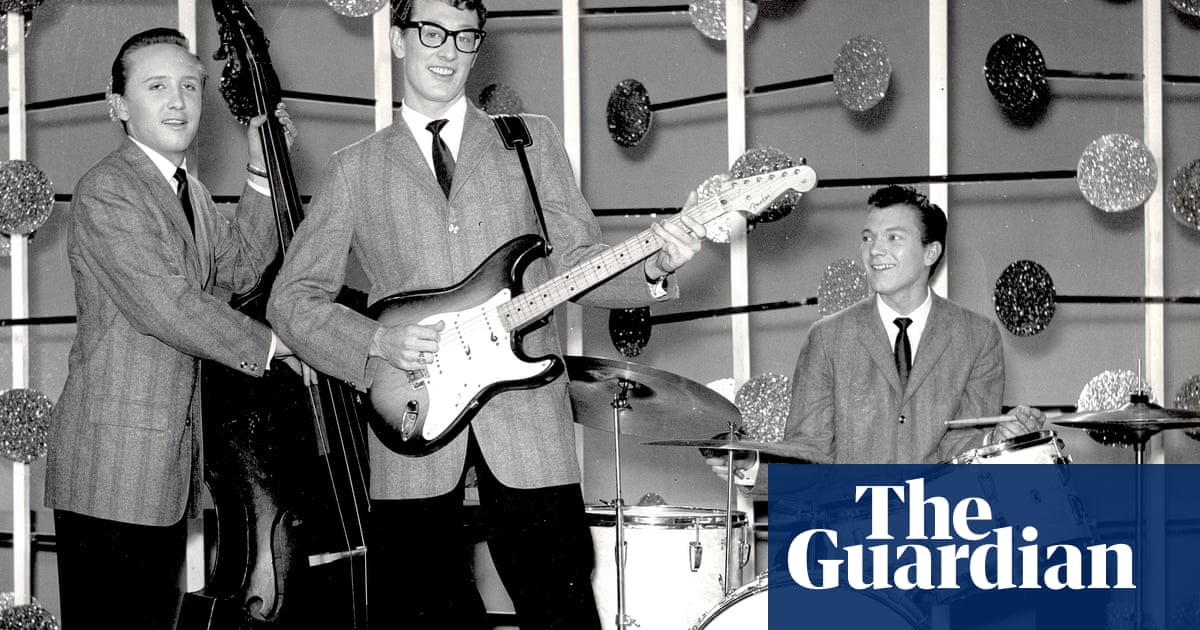
Jerry Allison obituary
Whenever three or four kids get together with an electric guitar or two, a bass and a drum kit and decide to write their own songs, whether they decide to call themselves the Beatles, the Ramones, Nirvana or something that they’re still arguing about, they are essentially following a template laid down by Jerry Allison and his friends in the city of Lubbock, Texas. That was back in a distant time when Dwight D Eisenhower was just starting his second term as president of the US.
Allison, who has died aged 82, was the drummer with the Crickets, who became known around the world in 1957, when their song That’ll Be the Day became one of the defining hits of the first rock’n’roll era. He had co-written it with Buddy Holly, their bespectacled singer and lead guitarist. A year later Holly left the group to pursue a solo career, and in 1959 he was killed in a plane crash, but his name and that of the group remain inextricably linked through such hits as Peggy Sue, Well … All Right and Think It Over, all of which Allison co-wrote.
Peggy Sue had first been titled Cindy Lou, borrowing the name of Holly’s niece, but was renamed at Allison’s request after Peggy Sue Gerron, his on-off girlfriend, whom he was trying to win back.
Released under Holly’s name, it was distinguished not just by the singer’s hiccuping delivery but by the galloping rhythm of Allison’s muffled tom-toms, rendered more exotic by a brainwave of Norman Petty, the producer, who turned the echo chamber on and off every few bars to create a startlingly unusual drum sound.
In those early days, when he was still in his teens, Allison was always ready to try something unorthodox. On the song Not Fade Away (which he claimed to have co-written, although the credit went to Holly and Petty) he played on a cardboard box to create a lightweight version of the celebrated Bo Diddley beat. On Everyday he slapped his knees. And on Well … All Right he played only his cymbals, underscoring the mood of wistful teenage reverie.
The son of Louise (nee Ferguson) and James, Jerry Ivan Allison was born in Hillsboro, Texas, and was known to his friends throughout his life as “JI”. In 1950, after his family had moved to Lubbock, he met Holly at junior high school.
In a world in which white youngsters were supposed to follow their parents’ example and listen to country music, the generation of Holly and Allison were entranced by the rhythm and blues they heard on black radio stations and by the hybrid form of rockabilly, with the records of Bill Haley and Elvis Presley acting as a guide to doing it for themselves.
As he took his own first steps in music, Allison admired the extravagant big band style of Gene Krupa, the most celebrated drummer of the era, and the driving work of Charles Connor in the Little Richard band’s incendiary appearance during the film The Girl Can’t Help It. “Buddy and I must’ve watched that film seven or eight times,” he remembered.
Two years younger than Holly, he was still in high school when he joined forces with the singer in 1955. The band was originally a three-piece, completed by a string bass player – first Larry Welborn, then Don Guess, and finally Joe B Mauldin. Later a rhythm guitarist was added, Sonny Curtis preceding and then replacing Niki Sullivan.
What made them different – and made a vital impression on the young John Lennon and Paul McCartney – was their determination to write their own songs.
The success of That’ll Be the Day, recorded at Petty’s studio in Clovis, New Mexico, was followed by hits with Peggy Sue, Maybe Baby and Oh Boy. Some were issued under Holly’s name, others as by the Crickets. Allison also had a small solo hit, under the name Ivan, with the novelty song Real Wild Child. Early shows across the US quickly led to bigger things and a 25-date tour of Britain in the spring of 1958 included an appearance on ITV’s Sunday Night at the London Palladium.
After Holly’s decision to move to New York and form a new band, the Crickets carried on for a while with other lead singers. In 1959 Allison and Curtis moved to Los Angeles, where they worked as session musicians. Allison can be heard on the Everly Brothers’ Til I Kissed You and Eddie Cochran’s Cut Across Shorty. The Crickets returned to the UK in 1960, unbilled, as the Everly Brothers’ backing band, and in 1964 under their own name. In 1970 Allison made a guest appearance on Eric Clapton’s first solo album. The Crickets were inducted into the Rock and Roll Hall of Fame in 2012.
His portrayal as a seemingly unsympathetic character in the 1978 film The Buddy Holly Story, on which he was not consulted, displeased him greatly. In 1987 he appeared in The Real Buddy Holly Story, co-produced by McCartney. He was the only ever-present member of the Crickets throughout the group’s existence, which ended with a farewell concert in 2016 at the Surf Ballroom in Clear Lake, Iowa, where Holly had appeared on the night of his death.
He married Peggy Sue Gerron in 1958, when he was 19 and she was 18. They porced in 1964. Allison is survived by his second wife, Joanie.































![iFi's GO Bar Kensei Dongle DAC Supports K2HD Technology With Some Samurai Swagger [Updated] iFi's GO Bar Kensei Dongle DAC Supports K2HD Technology With Some Samurai Swagger [Updated]](https://i0.wp.com/cdn.ecoustics.com/db0/wblob/17BA35E873D594/33FF/45A11/QTXOLJR4xDKSNMMk2WlTgjaIlvSgcYpeU1xJzUwIoYs/ifi-go-bar-kensei.jpg?w=768&ssl=1)
























